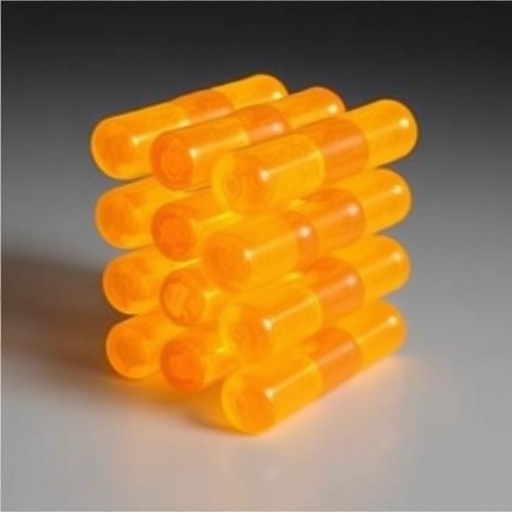In recent years, the growing concern over carbon dioxide emissions and their impact on climate change has spurred a wave of research aimed at developing effective methods for CO₂ reduction. Among the various strategies being explored, the use of catalytic materials to convert CO₂ into renewable energy sources has emerged as a promising solution. One of the latest advancements in this area comes from a groundbreaking study led by Zeng, Zhu, and Xia, which focuses on a novel Ni-doped flower-like BiOCl/MXene composite catalyst. This innovative catalyst is poised to enhance the performance of CO₂ reduction processes, potentially paving the way for more efficient and sustainable solutions to combat climate change.
The researchers begin their investigation by highlighting the importance of developing efficient catalysts for CO₂ reduction. Traditional catalytic processes often fall short in their ability to achieve desirable results, making it crucial to explore new materials with enhanced properties. In particular, the team identifies BiOCl as a highly promising candidate due to its unique crystal structure and favorable photocatalytic characteristics. However, they recognize that to maximize its efficiency, additional modifications are necessary.
To this end, the researchers introduce nickel (Ni) doping into the BiOCl lattice, which serves to improve the electronic properties and catalytic activity of the material. By strategically incorporating Ni ions, the researchers create a more active surface that can facilitate the CO₂ reduction reaction. This innovative approach not only enhances the catalytic efficiency but also opens up new avenues for further customization and optimization of the BiOCl structure.
Complementing the BiOCl component, the incorporation of MXene—a family of two-dimensional transition metal carbides—plays a crucial role in the overall performance of the catalyst. The unique layered structure of MXene provides an ideal environment for charge transfer, which is essential for efficient electron migration during the CO₂ reduction process. By combining these two materials, the researchers are able to create a composite catalyst that exhibits synergistic effects, thereby boosting the overall reaction rates and performance.
Experimental validation is key to assessing the efficacy of the Ni-doped BiOCl/MXene catalyst. The researchers conduct a series of rigorous tests under controlled conditions to compare the performance of their new composite material against traditional catalysts. The results are striking, demonstrating that the Ni-doped flower-like structure significantly outperforms its counterparts in terms of CO₂ conversion efficiency and selectivity. This breakthrough suggests that the innovative composite design not only enhances activity but also improves the stability of the catalyst over time.
The implications of this research extend far beyond the lab. As global efforts to mitigate climate change intensify, the ability to efficiently convert CO₂ into useful products becomes increasingly vital. The Ni-doped BiOCl/MXene catalyst has the potential to facilitate the production of renewable fuels and chemicals, contributing to a circular economy that relies less on fossil fuels. This transformative capability aligns closely with the needs of industries striving to reduce their carbon footprint, making this research especially relevant in today’s environmentally conscious world.
Furthermore, the design and fabrication of the catalyst are notable for their simplicity and scalability. The synthesis method employed by the researchers is both cost-effective and straightforward, allowing for the potential mass production of the catalyst without the need for complex procedures. This feature is critical for real-world applications, where the cost and efficiency of production can significantly influence the adoption of new technologies.
As the efficiency of CO₂ reduction catalysis becomes ever more crucial in the face of rising global emissions, the findings from Zeng, Zhu, and Xia represent a significant step forward. The continued exploration of innovative composite materials and catalytic techniques is essential to advance our understanding of CO₂ conversion processes. This research highlights the potential of interdisciplinary approaches combining materials science, chemistry, and environmental sustainability, setting the stage for future advancements in the field.
Looking ahead, ongoing research efforts will likely focus on optimizing the Ni-doped BiOCl/MXene catalyst further, exploring additional dopants, and refining the structural design. The possibility of integrating machine learning and artificial intelligence in catalyst development may also provide new insights into material performance. As the scientific community continues to grapple with the challenges posed by climate change, the integration of advanced materials and innovative methodologies offers a promising path toward achieving carbon neutrality.
In conclusion, the groundbreaking work of Zeng, Zhu, and Xia in developing a Ni-doped flower-like BiOCl/MXene composite catalyst represents a significant advancement in the quest for effective CO₂ reduction technologies. The potential for enhanced performance, stability, and scalability positions this research at the forefront of solutions to one of the most pressing environmental issues of our time. The transformative capabilities of this catalyst highlight the need for continued investment in innovative materials and processes to address climate change, reinforcing the idea that science has the power to drive meaningful change in the world.
As we continue to seek feasible solutions to reduce carbon emissions and transition towards sustainable energy sources, the work of these researchers serves as a beacon of hope. It embodies the spirit of innovation and collaboration necessary to tackle global challenges, reminding us that through science, we can forge a better future for generations to come.
Subject of Research: Ni-doped flower-like BiOCl/MXene composite catalysts for CO₂ reduction.
Article Title: Ni-doped flower-like BiOCl/MXene composite catalysts for enhanced CO₂ reduction performance.
Article References:
Zeng, X., Zhu, J., Xia, W. et al. Ni-doped flower-like BiOCl/MXene composite catalysts for enhanced CO₂ reduction performance.
Ionics (2025). https://doi.org/10.1007/s11581-025-06671-w
Image Credits: AI Generated
DOI: https://doi.org/10.1007/s11581-025-06671-w
Keywords: CO₂ reduction, BiOCl, MXene, nickel doping, catalysts, environmental science.




